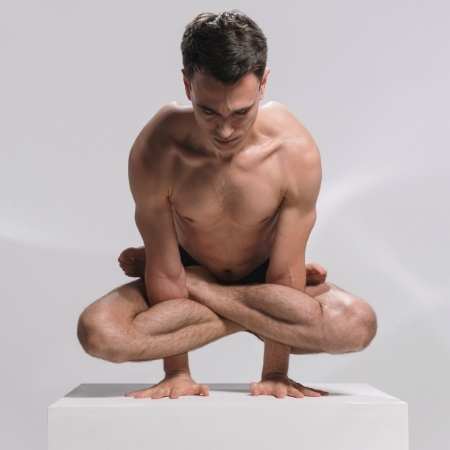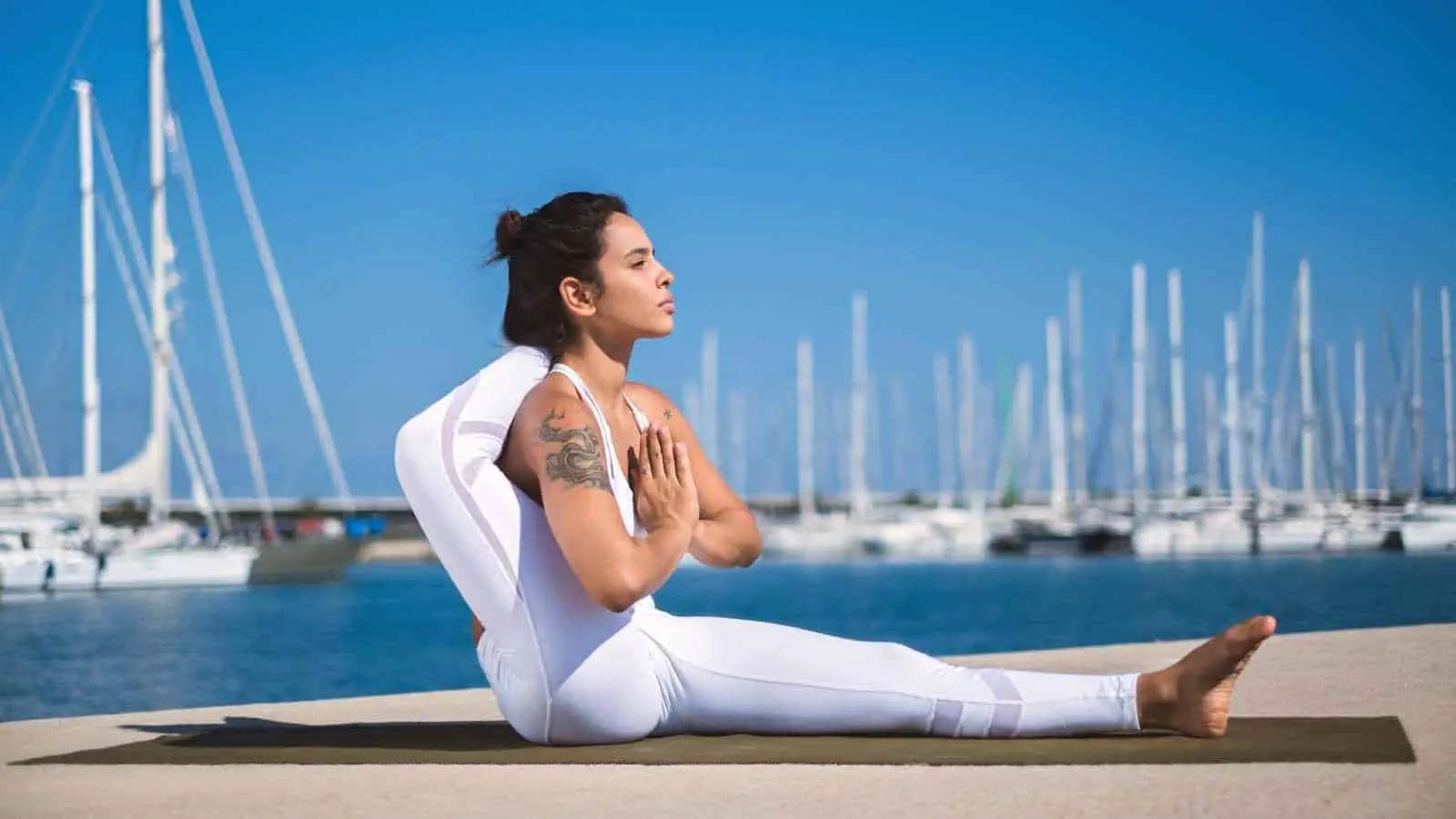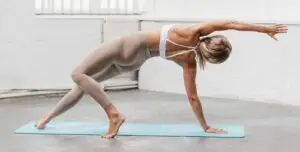Ashtanga yoga, also known as the eight-limb tradition or Mystore style, equally prioritizes the physicality of the practice, breath regulation, consciousness, focus, and lifestyle. Also, Ashtanga has six series: primary, intermediate, and four advanced levels. If you’re new to Ashtanga yoga, you may wonder if it’s difficult to practice.
Ashtanga yoga can be very hard if you’re not prepared to devote yourself to it. You may take many years to learn it. The primary and intermediate series in Ashtanga yoga requires dedication similar to training for a marathon or half triathlon. Advanced levels are only for experienced Ashtangis.
A beginner’s physical fitness, strength and agility, and endurance will influence how hard Ashtanga yoga is or can be. Also, regular practice, dedication, and a yoga teacher’s astute guidance can simplify and assist your transformation into an Ashtanga yogi or Ashtangi.
Why Is Ashtanga Yoga So Hard?
Ashtanga yoga is so hard because the asanas are complex and thus demanding, including many in the primary series. Also, Ashtangis must excel at not only the asanas or poses but also vinyasa (movement), pranayama (breath regulation), and Drishti (focused gaze).
In Sanskrit, Ashtanga means eight limbs (aṣṭā -“eight” and aṅga – “limb”) or eight-fold path of yoga. These eight limbs are:
- Yamas (restraint)
- Niyamas (rules)
- Asanas (yoga poses)
- Pranayama (breath regulation)
- Pratyahara (sensory control)
- Dharana (concentration)
- Dhyana (meditation)
- Samadhi (self-collectedness)
This article doesn’t cover the first two limbs – yamas and niyamas – that regulate everything about an Ashtangi’s lifestyle. Also, the last four limbs, pratyahara, dharana, dhyana, and samadhi, are supposed to develop and evolve naturally as an Ashtangi progresses from the intermediate to the advanced levels. Thus, this discussion is limited to the asanas and pranayama.
Ashtanga Is Not for Those Untrained in Elementary Yoga
Like all schools of thought and practice, irrespective of yoga, the first level or primary series of anything should be the easiest phase meant for beginners. However, this principle doesn’t apply to Ashtanga yoga, albeit the primary series is indeed the simplest among the six levels.
The primary series of Ashtanga yoga has around 14 standing poses, 21 sitting poses, and 13 finishing poses. At least six asanas among these have two or more variants, as prescribed by R. Sharath Jois, the lead exponent of Ashtanga yoga, also known as the Mysore tradition or style.
So, you have a few more than 50 asanas in the first level, which may take you several months or longer than a year to master. Those already practicing yoga or beginners with impressive fitness may master many of these asanas in a few weeks. However, other challenges exist.
Ashtanga Yoga Demands Time
Your first session may last only fifteen to twenty minutes. However, you have to spend over an hour sooner than later if you want to master all the primary series asanas. Also, aspiring yogis need a realistic schedule for the sessions as you can’t start doing Ashtanga at random times.
Each Ashtanga asana requires strict breathing regulation, including holding a pose and breath for the mandated duration. Also, Ashtangis must practice accurate drishti (focused gaze) for all poses throughout a session. This rule applies to the transitions of vinyasa, too.
Thus, you have to train your physical self, breathing, and mind or consciousness to concentrate while practicing. It’s difficult to control so many aspects if you’re in haste, a pending task distracts you, or you’re not in an ideal mental state to give it all you have for the asanas.
Ashtanga Yoga Demands Strength, Agility, and Endurance

A few poses in the primary series can be intimidating for beginners, such as supta kurmasana (sleeping tortoise), kukkutasana (rooster pose), and sirsasana (headstand). Also, a yogi should sustain these poses for the required number of breaths while keeping the focused gaze.
Those untrained in elementary yoga cannot practice these asanas straightaway. You have to enhance your strength, agility, and endurance while also working on your concentration, breath regulation, and the flawlessness required for each complex asana, even in the primary series.
Note: Ashtanga yoga doesn’t demand a practitioner to master all the poses in any specified timeframe. Certified Ashtanga yoga teachers and instructors include the complicated asanas in a beginner’s session only when one has mastered the elementary poses, never otherwise.
Ashtanga Yoga Intermediate Series Is Essentially an Advanced Level
The second level has standing, intermediate, and finishing asanas. There are around 12 standing poses and variants, all of which but one are in the primary series. The intermediate section at this level has around 30 asanas, and you finish with 13 closing poses. Ideally, an Ashtangi starts with the first standing pose and does all asanas until savasana (corpse pose).
Ashtanga Is Boring for Some Aspiring Yogis
Some beginners may find Ashtanga yoga boring because they have to practice the same poses and their variations until perfection. Only then can a yogi progress to the intermediate series or second level of Ashtanga yoga. There’s no premature progression, as that’s unsafe.
Certified yoga teachers may modify a few vinyasas and the sequence of the standing, sitting, and finishing poses to make a session interesting. However, the daily or weekly routine remains the same essentially. Thus, Ashtanga yoga is ideal for those willing to commit for the long term.
If you find that the primary or first level is challenging, the intermediate series tests your mettle further. However, those graduating to the second level are already pretty sorted with the demands of Ashtanga yoga. Thus, the journey can become an adventure for most aspiring Ashtangis.
Some beginners may rue the lack of fun, playfulness, and variety in Ashtanga, especially in contrast to hot or power yoga and a few other styles. On the positive side, yogis discover new facets of their strength, agility, endurance, and consciousness through Ashtanga.
Ashtanga Yoga Tests Your Mental and Physical Limits
Several asanas in the primary and intermediate series of Ashtanga yoga demand incredible exercising of the core, quadriceps, and all muscles, tendons, ligaments, and the entire skeletal structure, of course. Also, yogis experience a newfound blissful state of mind. In time, dedicated Ashtangis realize that the common perceptions about physical flexibility are misplaced.
The problem is the time, effort, commitment, and practice necessary to reach a strong, agile, and blissful state. There are no shortcuts in Ashtanga. Either you can perform an asana, or you cannot. Also, you breathe correctly or incorrectly, in an unfailingly focused or distracted state.
Ashtangis and the Elusive Samadhi
The third Ashtanga level is the first in the advanced series. Known as Advanced A, this series has almost four dozen asanas, including the vinyasas. Many of these asanas have multiple poses in transition. Conquering the primary and intermediate series doesn’t guarantee that an Ashtangi will find the advanced level less intimidating. At this stage, you’ll play against gravity.
Only one yogi is believed to have mastered the sixth series of Ashtanga, Rangaswamy Sharath Jois, the grandson of Krishna Pattabhi Jois, who was the father of the contemporary Ashtanga or Mysore style of yoga. While there are Ashtanga yoga teachers trained by R. Sharath Jois, you may not find anyone around you who has attained samadhi, the ultimate objective.
You can probably imagine how hard the four advanced levels are if those practicing for decades are yet to achieve the trifecta of physical, spiritual, and conscious samadhi. Still, invaluable rewards await all yogis, starting with the primary series, and some become Ashtangis for life.
Conclusion
Ashtanga yoga is hard from the outset, and it gets more challenging and rewarding as you progress. Whether or not the Ashtangi lifestyle is for you depends entirely on your objective. Everyone can’t become an Ashtangi, but those practicing Ashtanga become strong and blissful.





